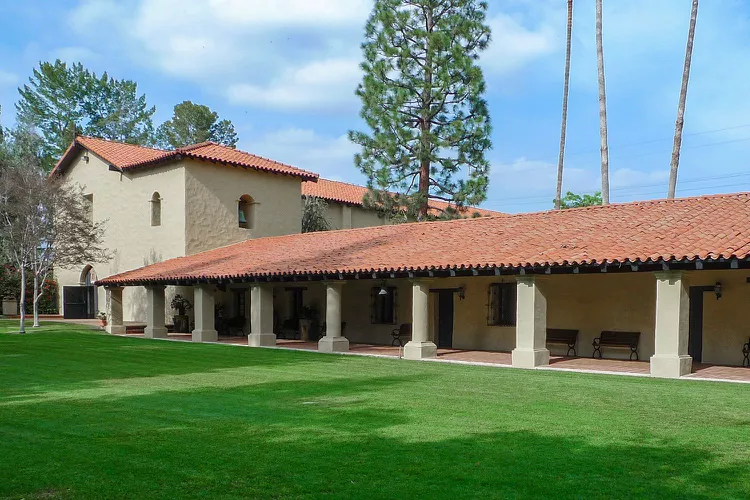Summary of Mission San Fernando
- Interesting Facts – Discover notable historical facts about Mission San Fernando.
- Location – Find out where Mission San Fernando is located.
- History – Explore the history of the mission from its founding until today.
- Architecture and Layout – Learn about the layout of Mission San Fernando and its significant buildings.
- Artifacts and Offerings – Understand the key artifacts and offerings related to the mission.
Mission San Fernando was the seventeenth Spanish mission built in California. It was founded on September 8, 1797, by Father Fermin Lasuen. The name San Fernando de Espana was to honor Saint Ferdinand III, King of Spain.
Interesting Facts about Mission San Fernando
Many travelers stopped at the mission, leading to continuous additions to the convento wing to accommodate them. The hospice (hotel) became known as the “long building” along the El Camino Real.
Notably, actor Bob Hope is buried in the mission cemetery.
Where Is Mission San Fernando Located?
Mission San Fernando is located at 15151 San Fernando Mission Blvd, Mission Hills, CA.
For current hours, visit the mission website.
History of Mission San Fernando: 1827 to Present Day
The Spanish discovered the San Fernando Valley in 1769. In the late 1790s, Father Lasuen, successor to Father Serra, aimed to close the gaps in the El Camino Real. Consequently, in 1797, he established four missions within four months, including Mission San Fernando.
The mission was founded on September 8, 1797, named after Saint Ferdinand III, King of Spain in the 1200s. On the same day, five Indian boys and five girls were baptized at the mission.
Early Years of San Fernando Mission
The San Fernando Mission church was completed shortly after the dedication, and by that time, over 40 neophytes resided there. Because of its proximity to the Los Angeles pueblo, there was a strong market for the mission’s goods. Its advantageous location attracted many visitors.
By 1804, almost 1,000 indigenous people lived at San Fernando Mission, engaging in cattle ranching and producing goods like hides and cloth by 1806.
San Fernando Mission from 1810-1830
In 1810, renovations began on the convento (the priest’s residence), which took twelve years to complete. However, after 1811, the native population began to decline, affecting productivity and farm output.
After Mexico gained independence from Spain in 1822, various groups fought to control the mission land. Although there were land grants for some Indians in the valley, most remained reliant on the San Fernando Mission.
Secularization at San Fernando Mission
Beginning in the 1830s, California officials initiated the takeover of mission lands. Most of the indigenous population sought work elsewhere or returned to familial roots in the nearby hills during this period.
Father Ibarra eventually left in 1835 due to the growing secularization. The discovery of gold nearby in 1842 intensified the competition for the area, resulting in conflicts over land ownership.
San Fernando Mission in the 20th Century
In 1923, Mission San Fernando regained its status as a church, and control of the property was handed over to the Oblate Fathers. Artifacts from the mission, such as the original fountain and other historical items, are now showcased in a nearby park.
The mission’s close proximity to Hollywood has rendered it a popular location for filming various movies.
Mission San Fernando Layout, Floor Plan, Buildings and Grounds
Mission San Fernando quickly outgrew its original structures, adding barracks, workshops, and storerooms around the quadrangle. Noteworthy is that the church measures 185 feet long and 35 feet wide with walls tapering from five feet thick at the bottom to three feet thick at the top.
The original convento was completed in 1822, and U.S. Army Colonel John C. Fremont utilized it during his control of California in 1847.
The successful healing of the mission from earthquake damages in 1812 was unfortunately subject to vandalism in later years; roof tiles were repeatedly removed, exposing the adobe walls to deteriorate.
Though restoration efforts began in 1923, further earthquake damage occurred in 1971, necessitating the construction of exact replicas of the original buildings.
Mission San Fernando Cattle Brand
In 1819, San Fernando Mission thrived with a herd of 13,000 cattle and 8,000 sheep while maintaining the third-largest herd of horses at any mission.
The mission’s cattle brand illustrates its agricultural significance, derived from samples displayed at Mission San Francisco Solano and Mission San Antonio.
Mission San Fernando Interior
This mission stands as an exact replica, having been rebuilt following extensive earthquake damage.
The ornate screen behind the main altar is referred to as a reredos—an important feature within the mission’s interior space.
Mission San Fernando Bishop’s Room
California’s first bishop, Francisco García Diego y Moreno, resided in the San Fernando convento from 1820 until 1835, showcasing the mission’s historical importance.
Mission San Fernando Governor’s Room
The mission also featured a room designated for high-profile guests, commonly referred to as the “governor’s chamber,” which offered enhanced comfort compared to standard accommodations.





